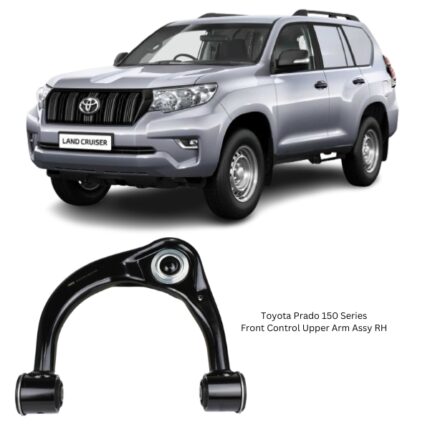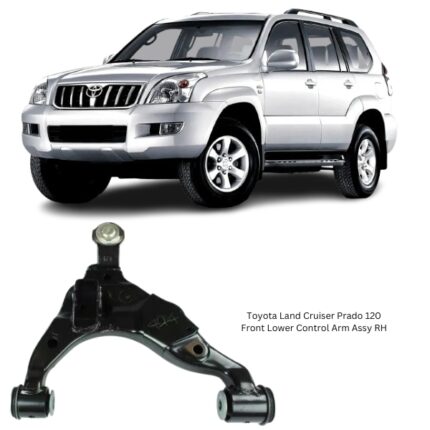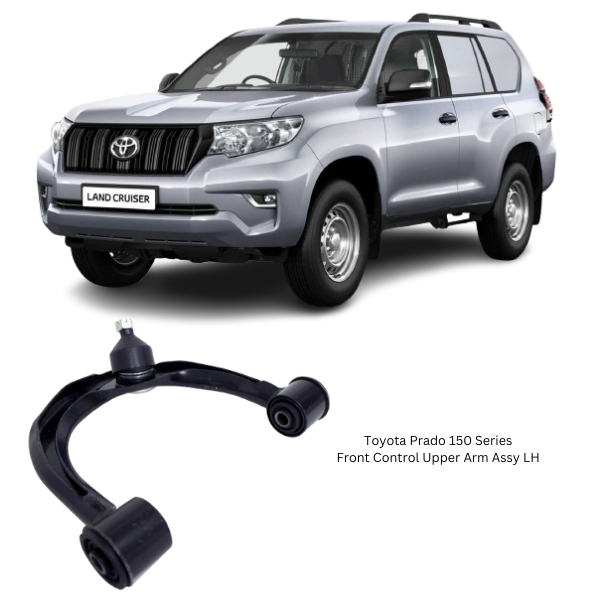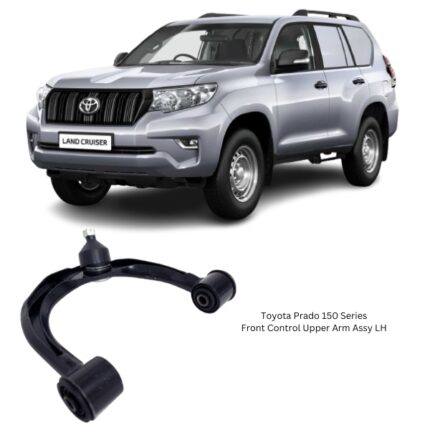Get Toyota Land Cruiser Prado 150 Front Control Upper Arm Assy LH 48630-60040 in Kenya
The Front Upper Control Arm Assembly LH (Left-Hand) is a critical suspension component positioned above the front left wheel. Designed to function as an essential link between the chassis and the wheel hub, this part governs the upward and downward movement of the wheel while maintaining alignment and steering stability. It works in conjunction with the lower control arm to keep the wheel properly aligned, ensuring that it moves smoothly and predictably through the range of suspension travel.
This component plays a crucial role in vehicle dynamics, particularly in handling, alignment, and road contact. Without a properly functioning upper control arm, the wheel would lack the controlled guidance needed to maintain correct alignment geometry under varying loads and terrain conditions.
Construction and Design
The Front Upper Control Arm Assembly LH is typically manufactured using robust materials engineered for strength and long-term durability. Depending on the application and intended vehicle performance, materials may include:
-
Stamped Steel: Offers reliable durability and structural integrity while maintaining cost-efficiency.
-
Forged Aluminum: Preferred in performance or lightweight applications due to its strength-to-weight ratio.
-
Cast Iron: Common in heavy-duty applications requiring superior strength and wear resistance.
Each control arm assembly is comprised of several key components:
-
Arm Structure: A triangular or wishbone-shaped arm that links the chassis to the steering knuckle. The design is intended to support pivoting motion while handling lateral and vertical forces.
-
Ball Joint: A spherical bearing at the outer end that connects the arm to the steering knuckle. It allows for controlled pivoting and up/down wheel motion as well as rotation during steering.
-
Bushings: Located at the pivot points where the arm mounts to the vehicle frame. These rubber or polyurethane sleeves reduce vibration and allow limited flexibility while maintaining stability.
-
Protective Coating: Most assemblies come treated with anti-corrosion finishes, such as powder coating or e-coating, to protect the arm from rust, road salt, and other environmental hazards.
Functionality and Operation
The Front Upper Control Arm Assembly LH serves several key purposes within the vehicle’s suspension system:
-
Maintains Camber and Caster Angles: Helps manage the vertical position of the upper part of the wheel, maintaining proper tire alignment to the road surface.
-
Controls Suspension Travel: Guides the wheel through its range of motion, supporting smooth vertical movement while limiting unwanted lateral shifts.
-
Transfers Road Forces: Acts as a structural bridge, transferring braking, cornering, and impact forces from the wheel hub to the chassis.
-
Supports Steering Geometry: Plays a direct role in ensuring the wheel maintains alignment during steering, turning, and straight-line driving.
By maintaining precise suspension geometry, the upper control arm contributes significantly to both handling accuracy and ride comfort.
Advantages of a High-Quality Upper Control Arm Assembly
A durable and properly engineered Front Upper Control Arm Assembly LH offers numerous advantages:
-
Improved Steering Control: Maintains consistent alignment and handling response under both normal and demanding driving conditions.
-
Reduced Tire Wear: Prevents camber misalignment that can lead to irregular tire wear, increasing tire lifespan.
-
Enhanced Ride Comfort: Helps absorb road vibrations and minimize harshness transmitted to the vehicle cabin.
-
System Compatibility: Works in harmony with other suspension components such as lower arms, sway bars, shocks, and springs.
-
Extended Service Life: High-quality bushings and ball joints reduce wear and resist premature failure under stress.
Symptoms of Wear or Failure
Like all suspension components, the Front Upper Control Arm Assembly LH is subject to mechanical wear over time. Early detection of issues can prevent further damage to the suspension system. Some of the common symptoms of wear include:
-
Clunking or Popping Sounds: Often heard during turns or when going over bumps, this noise usually indicates worn-out bushings or a failing ball joint.
-
Uneven Tire Wear: A misaligned upper control arm can change camber angles, causing the tire to wear unevenly across its tread surface.
-
Steering Pull or Drift: If the arm is bent or the bushings are degraded, the vehicle may pull to one side during driving.
-
Steering Instability or Play: Worn joints can cause excessive movement in the wheel hub, leading to imprecise or delayed steering response.
-
Vibration in Steering Wheel: Caused by looseness or movement in the control arm assembly.
-
Visible Damage: Cracked bushings, loose joints, rust, or a bent arm structure may be noticeable during visual inspection.
Installation Guidelines
Proper installation is essential to ensure that the new control arm restores alignment and handling characteristics. Here’s a general overview of the replacement process:
-
Vehicle Preparation: Safely lift and support the vehicle using jack stands, then remove the front left wheel to access the control arm assembly.
-
Remove Damaged Arm: Disconnect the ball joint from the steering knuckle and unbolt the arm from the frame or mounting points.
-
Install New Assembly: Position the new control arm into place, aligning all mounting points.
-
Reconnect Ball Joint: Reattach the ball joint to the knuckle, ensuring the joint is secure and seated correctly.
-
Torque Fasteners: Use a torque wrench to tighten all bolts and nuts to the manufacturer’s specifications.
-
Alignment Check: After installation, a professional wheel alignment is necessary to ensure proper suspension geometry.
Correct installation ensures safe operation, restores steering response, and prevents premature tire wear.
Maintenance and Care Tips
Although designed to be low-maintenance, the Front Upper Control Arm Assembly LH benefits from routine inspection and care:
-
Inspect During Routine Service: Check for cracked bushings, grease leaks from the ball joint, or excessive movement in the arm.
-
Clean Undercarriage: Remove debris, mud, and salt to prevent corrosion, especially during wet or winter seasons.
-
Monitor Handling Behavior: Any change in ride comfort, tire wear, or steering response should prompt a suspension check.
-
Replace Bushings or Ball Joint When Needed: In some designs, the ball joint or bushings may be serviceable individually. In others, the entire arm may need replacement.
-
Avoid Heavy Impact: Avoid hitting potholes or curbs at high speed, which can bend or fatigue the control arm and associated components.
Precision Fitment Importance
Ensuring that the control arm matches the exact orientation—LH (Left-Hand)—and suspension design is critical. Incorrect fitment can result in:
-
Misalignment of suspension geometry
-
Increased tire and component wear
-
Steering inaccuracy or binding
-
Reduced ride quality and safety
OEM-spec parts or high-quality aftermarket equivalents ensure compatibility and long-term performance
Follow us on Facebook for more parts.





Reviews
Clear filtersThere are no reviews yet.